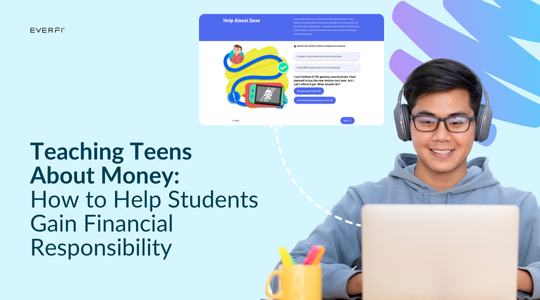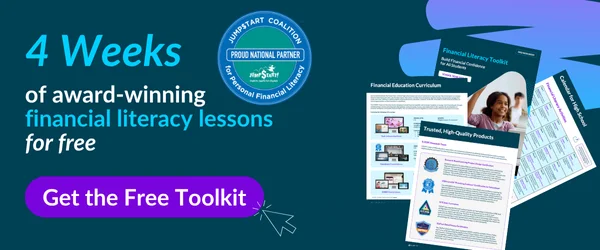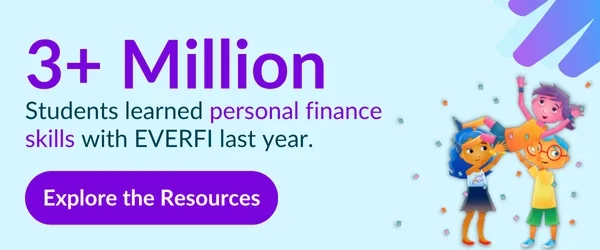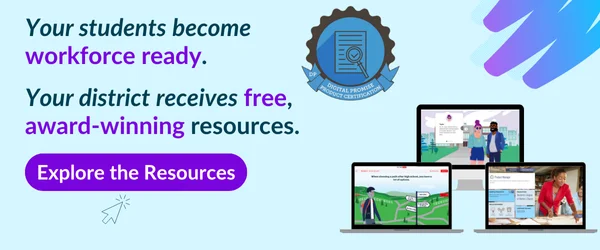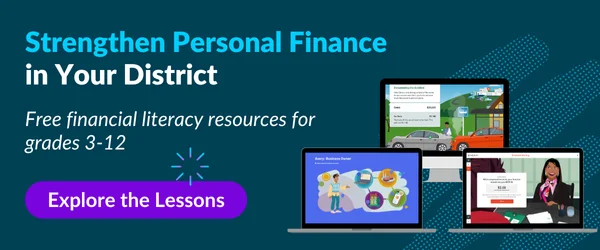What if schools consistently failed to teach the most important lesson?
Every year, more high school graduates struggle with money, ending up with far too many bills and far too few paychecks. Clearly, the best way to prevent this from happening is for schools to offer better financial literacy programs.
Unfortunately, it’s equally clear that the standard mathematics curriculum does not prepare students for important activities like budgeting, saving, and even balancing a checkbook.
The good news is that teaching teens about money is easier than you might think. With the help and resources of Everfi, teachers and administrators can transform their classrooms into places where students learn the financial literacy skills teens need to survive life after high school. To learn more about how to transform your own school, keep reading to discover how to teach teenagers about money as early as today!
Main Takeaways
- Teachers must step up because parents alone cannot provide proper financial education to their children.
- Most of the country is financially illiterate, showcasing the need for financial literacy lessons.
- Providing teens with financial literacy lessons early on will help them become better at managing money without getting into debt or destroying their credit.
- Combining custom lesson plans with educational technology solutions is the best way to teach teens the value of money.
Table of Contents
- Complementing Parental Guidance
- The 8 Most Important Money Lessons to Teach
- Incorporating Financial Literacy in the Classroom
- Inclusivity: Accounting for Different Socioeconomic Backgrounds
- Everfi Can Help Incorporate Lessons Into Your Classroom
Complementing Parental Guidance
Teaching teens financial responsibility is easier than ever, thanks to the comprehensive suite of financial education lessons from Everfi. However, it is important for the lessons learned in the classroom to continue at home. After all, home is where students will put their growing financial literacy skills to the test by earning extra money, saving for things they want, and even contributing to household expenses once they get a job. Administrators can get community “buy-in” for the new or strengthened focus on financial literacy by hosting events such as FAFSA Night, where counselors help families navigate the financial aid process and learn a few personal finance skills along the way.
Sadly, parents won’t always be able to help. According to the World Economic Forum, the majority of American adults are financially illiterate. Because of this, some of them may push back against financial literacy programs because they don’t want their children asking money-related questions that their parents cannot answer. This underscores the need to teach teens about money in the classroom, effectively breaking a cycle of ignorance that could easily become crippling generational poverty. These programs allow teachers to do what they do best: give students the skills they need to improve their lives.
The 8 Most Important Money Lessons to Teach
Teachers are always racing the clock, trying to fill the hours with as much instruction as possible before the bell rings. Therefore, they must prioritize the most important lessons for any given subject they teach. What, then, are the most crucial lessons for teens to learn, and how can teachers go about providing them? Below, we’ve got a full breakdown of everything you need to know.
Budgeting
Teens must learn to budget before they can truly learn the value of money. Unfortunately, only 22 percent of teens understand investment or generally money-growing methods and opportunities. However, parents and teachers can address this deficit by teaching students valuable budgeting lessons such as the 50/30/20 rule, in which 50% of funds go to necessary expenses, 30% go to fun things, and 20% goes into savings, the latter of which can be invested for additional financial growth.
Credit Cards and Scores
College students are heavily reliant on credit. In fact, 50% of those 18-24 have a credit card. To make sure these students don’t sink into debt and potentially ruin their credit score, it is important for parents and teachers to provide instruction on how to raise and maintain a credit score as well as how to avoid borrowing more than they can easily pay off. Such lessons offer students the financial savviness they need to succeed in college and beyond.
College Financing
A college degree is the gateway to both learning more and earning more, but attending such institutions isn’t cheap. Many students have to take out debt; in fact, 28.6% of undergrads take out federal loans. To keep today’s students from landing in major debt, parents and teachers need to help students understand the full costs of college as well as different ways of paying for it (including how to apply for scholarships and grants). The better instruction teens get now, the less likely they are to land in major debt after they enroll in college.
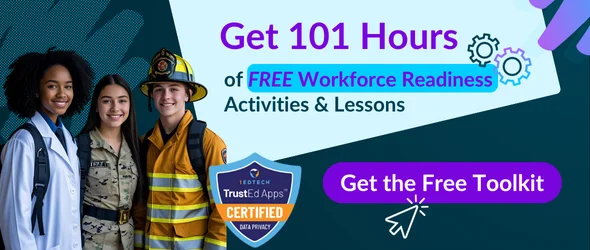
Wants vs. Needs
Teens can be very impulsive, and when it comes to money, that usually means spending too much on things they don’t really need. To counteract that, parents and teachers need to instruct students about wants vs. needs … that is, which items are necessary for survival and which are not. It’s possible to integrate this into in-class lessons where students discuss what items represent wants or needs by looking around the classroom or examining a list of items on a handout. Beyond this simple concept, it’s also important for teens to learn the 24-hour rule, where they must wait a full 24 hours to decide how badly they want an item before spending money on it.
Creating Emergency Funds
One of the most shocking statistics you can tell teens is that 40% of Americans are only one missed paycheck away from poverty. There are many factors behind this, including the difficulty of finding well-paying jobs. However, the primary driver of this statistic is that far too many Americans are too accustomed to living paycheck to paycheck rather than saving up for future emergencies. Because of this, it’s important to teach teenagers about the importance of emergency funds and having a minimum of three monthly paychecks saved up in case they should lose their job or face unexpected financial hardships.
Identity Protection
Far too many students underestimate the risk that identity theft poses to their lives and lifestyles. In 2021, 23.9 million United States residents 16 or older were victims of identity theft. The goal of these thieves is to gain access to bank accounts and credit card accounts, and once they have access, it is far too easy for them to siphon away money before disappearing without a trace. All of this added up to $16.4 billion in stolen funds in 2021. To keep their own students from becoming part of this grim statistic, it is important for teachers and parents alike to educate students against scams (including electronic phishing scams) designed to gain access to sensitive personal information.
Banking Fundamentals
No matter how much or how little money a teen has, they will eventually need to store it all in a bank for safekeeping. However, this can be very confusing for many of them: recent studies have found that over one-third of American teenagers don’t have their own bank account. It’s important for schools to review banking fundamentals, including how to open and maintain an account and how to avoid overdrafting. Emphasizing these lessons now ensures that students can do a better job of keeping their money safe while growing their wealth over time.
Understanding Paychecks
After they graduate, it’s very common for students to gripe about what they weren’t taught in school. For example, many graduates use memes to express frustration that they never learned basic information about topics such as balancing checkbooks and how paycheck taxes work. Considering that over half of Americans think they pay more than their fair share of taxes, it’s important for educators to emphasize practical lessons about how to read a paycheck, including how to understand its deductions. Once students know more about how much money is coming in with each paycheck, it is easier to teach them about balancing their checkbook and generally living within their means.
Incorporating Financial Literacy in the Classroom
Once you understand just how many adults in the country are illiterate about money management, it’s easy to understand the need to offer financial literacy programs in K-12. However, it’s much harder to figure out how to teach teens about money. Just what can you do in the classroom to drive these lessons home, especially if you teach something other than math?
The first thing you should consider is conducting engaging activities, such as mock stock markets, investment games, and real-world budgeting challenges. Students often respond well to these activities because they bring math to life, emphasizing that a solid understanding of the subject can help them make more money and live a more comfortable life. This understanding blossoms through different hands-on activities that reinforce mathematical concepts like calculating compound interest and calculating percentages for tips and taxes (tax simulations are great for teaching the latter).
Older students may benefit from fundraising activities that give them a chance to raise and spend money on a good cause, and they might also benefit from field trips to financial institutions to learn more about managing money. Regardless of the subject you teach, the best way to incorporate lessons about money in your high school is through embedded online and in-person activities via educational technology companies like Everfi.
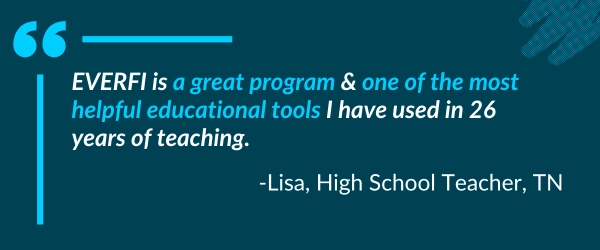 (opens in new tab)
(opens in new tab)
Inclusivity: Accounting for Different Socioeconomic Backgrounds
Teachers and administrators have their hearts in the right place when teaching teens about money. However, if those money management lessons don’t account for students having different socioeconomic backgrounds, then the school may accidentally be excluding much of its student body. Fortunately, there are a few easy ways that school districts can create more inclusive environments that account for different socioeconomic backgrounds.
For example, ensure that in your lessons, you don’t assume that students automatically come from privileged backgrounds or have access to robust financial resources. After reviewing basic economic concepts, make sure to use diverse case studies throughout the lessons that showcase a wide range of financial situations and challenges and emphasize how resourcefulness and creativity can help students overcome many challenges, regardless of their socioeconomic status.
It’s important to make students aware of local community resources and programs that may help them and others achieve financial stability. Finally, be sure to emphasize that financial success looks different for everyone. Rather than focusing on accumulating a certain amount of wealth, students should instead develop their own financial goals and then work diligently toward accomplishing them.
This can be hard to do, especially because students are oversaturated with media trying to tell them what success looks like. But with the right lessons, students can see through such messaging and focus on achieving financial success on their own terms.
Everfi Can Help Incorporate Resources Into Your Classroom
Everfi offers a number of instructional resources as part of its Financial Literacy Collection that you can embed into your classrooms. These free, research-based, standards-aligned courses are aligned with Jump$tart National Standards in K-12 Personal Finance and come with the prestigious ISTE seal. As Diana Pate, HS teacher from Rockwell, TX, said, “Financial literacy is important for students because it helps them learn how to manage their money effectively and helps them learn to plan for financial hardships and real life. Financial literacy is a necessary life skill that I wish I had learned in school. With Everfi in your corner, teaching teens financial responsibility has never been easier!”

Chris Snellgrove is a college writing professor with over 15 years of experience as a teacher, professor, and instructor. He’s primarily taught at the high school and college levels, but has also led ESL programs for primary school students. In addition to his teaching experience, he has extensive experience with SEO, small business optimization, and ghostwriting for hundreds of clients in all different fields.
Free for K-12 Educators
Thanks to partners, we provide our digital platform, training, and support at no cost.
See why 21K schools use Everfi.
